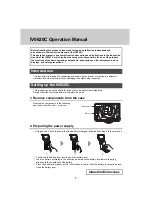
14
man_digiflex_com_en_02_5.doc
For measuring the distance to the fault, a movable cursor or a combination
of marker and cursor are used. Distance is display in m, ft, or µs as
selected by the user. In order for the distance to be indicated in m or ft, the
pulse propagation velocity of the cable under test has to be entered before
the test is carried out.
The greatest advantage of the pulse reflection method is its ability not only
to find out that there is a fault but also to find its location and type.
The
Digiflex Com
allows two cables under test to be connected to L1 and
L2 at the same time and to show two reflectograms simultaneously. This
can be done using currently taken reflectograms or test results stored in
memory.
The most important modes of testing are:
Reflection measurement Pair (physical circuit) versus Built-in balancing
network (dummy line)
Difference measurement of two pairs
Location of crosstalk (NEXT) Pair versus Pair (k1 measurement)
Measurement of time-variable (intermittent) faults (IFL)
There are two display modes the user can choose between. When you
wish to get a revealing overview of the cable under test and, at the same
time, have a closer look at a cable section, you can choose the display
mode which divides the screen of the
Digiflex Com
into two windows. The
upper window shows the full distance range with a movable window
marking a section the content of which is displayed zoomed in the lower
window. There is yet another display mode with a full-screen display of the
selected cable section.
Current device settings are display by the LCD. When a stored
reflectogram is uploaded as trace 1, all relevant settings such as gain and
NVP are also taken over from memory thus allowing the current test result
to be easily compared with a reflectogram taken earlier.
The
Digiflex Com
is powered from a NiMH rechargeable accumulator fitting
in a accumulator compartment in the bottom of the unit. The instrument has
a Power-Down mode. Moreover, the unit can also be powered from an
external source of power.
Summary of Contents for Digiflex Com
Page 2: ...2 man_digiflex_com_en_02_5 doc...
Page 3: ...man_digiflex_com_en_02_5 doc 3 Digiflex Com compact and light weight Time Domain Reflectometer...
Page 4: ...4 man_digiflex_com_en_02_5 doc...
Page 8: ...8 man_digiflex_com_en_02_5 doc...
Page 44: ...44 man_digiflex_com_en_02_5 doc...















































